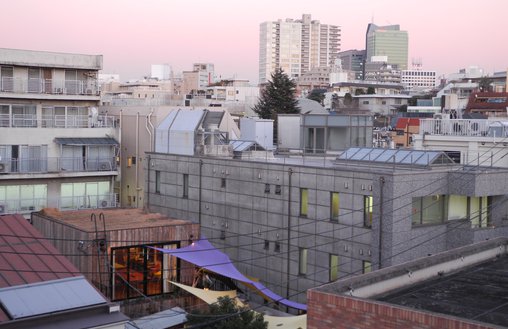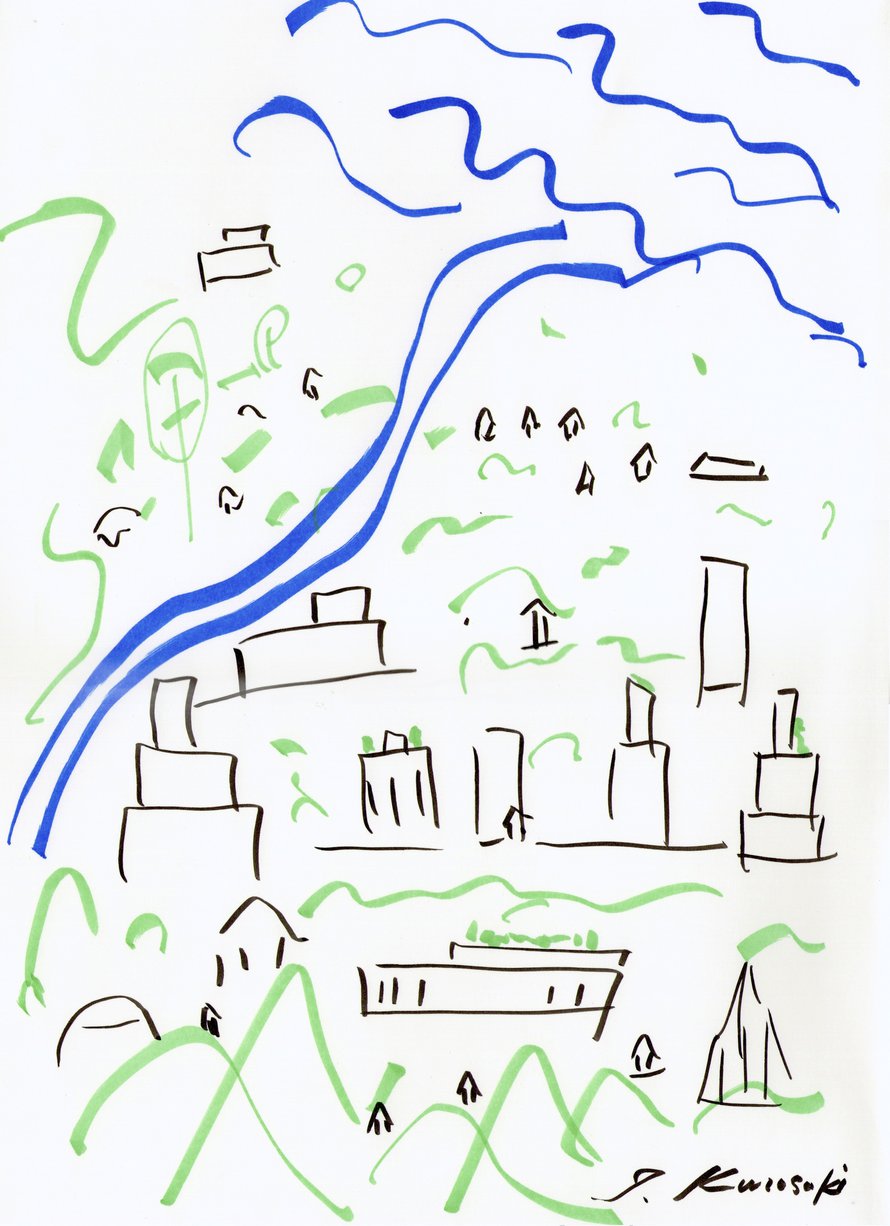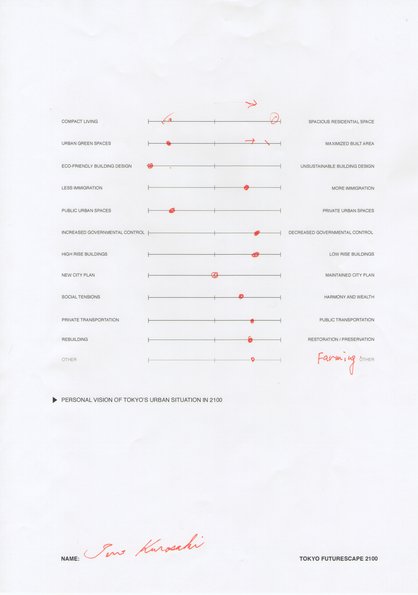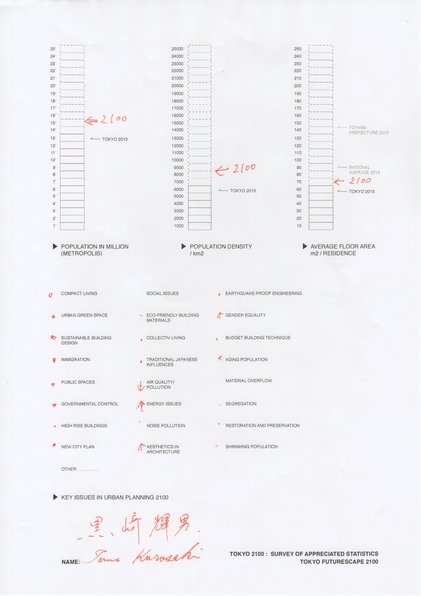Futurescape Tokyo is
a study in urban
fantasies and speculative
cartography. The project aims
to explore potential future
scenarios of the world's
largest megalopolis Tokyo,
which is expected to
shrink dramatically
during the next 86 years.
INTERVIEWS & MAPS
TERUO KUROSAKI
Sometimes called a "design philosopher", the influential design impresario and innovative producer Teruo Kurosaki describes himself as an editor of space and design. With one ear to the ground, always sniffing out the tendencies of our time and supporting young talents, he deals with the meaning, methods and values of design. Design today is less about form and more about creating situations in the city, he says.
We meet in his restaurant on the forth floor of the Gyre building, one of the spectacular commercial and retail complexes that frame the fancy shopping street Omotesanto in Jingumae. The man behind the design and furniture empire Idee/Sputnik and the Tokyo Designers Block, started out by importing antiques from Europe in the 70s and became a key figure in introducing Western contemporary design to Japan. Along the way, Teruo Kurosaki helped several designers to gain international recognition – among the most renowned are Shiro Kuramata, Marc Newson and Philippe Starck.
This crispy winter day he is enthusiastic over one of his current missions: the Tokyo Farmer's Market, where more than 40 stallholders gather every weekend to sell locally grown fruit, vegetables, rice and other foods, combining culture and cultivation in the middle of the megalopolis. The time has come to leave behind the quest for economical wealth that has characterized Japan since the post-war bubble-economy, he says. Instead, the future lies in a closeness to nature and environmental-friendly ideals.
How would you describe Tokyo as a city today?
It is chaotic. Very traditional, but at the same time very mixed up with foreign influences. There are strong influences from Western society but there are also still traditional Japanese elements, especially in relation to the nature and the food. And there is also a mixture of reality and surrealistic things. If you go to Harajuku for example, you can see young people living in a fantasy. The kawaii culture and all that. What the express is their dream of Western civilization, but it is actually in their own way. It is all mixed together.
You refer to the relation with nature as a traditional Japanese element in Tokyo. How is that special relation to nature is expressed in Japanese design and architecture?
It is hard to explain, but I like to compare Japanese interior design with a stage set. The Japanese garden is a copy of a natural scenery, but in its own way. Architecture in Japan is often wooden based, made out of beautiful wood, very ephemeral and temporary, like a stage set. The features are a little bit similar to the Swedish wooden cottage. I feel very close to that aspect of Swedish culture. I think both Japanese and Swedish designers and architects are facing towards the nature, instead of fighting it.
What do you consider the biggest challenges for Tokyo as a city right now?
We live in a time when people alll around the world are looking for what way to go next, what direction to choose for the future. But still they have not found a solution, not yet. So, people are focusing on the amount of things: the numbers of banking, of orders. Number two, number three, number four… I think that we should focus less on expanding the amount and numbers of production and instead focus more on finding the quality of culture and design. Japan is not like China, trying to produce big quantities of things. I think Japan needs to change towards more quality, more culture and more truth in the production of things. We start with the farmer's market, selling vegetables from the mountains in the centre of Tokyo. It is a way to connect farmers and costumers directly and enable a meeting that has been lost for a long time. This is how we work. We connect the nature with the city, the new with the old and build bridges like that.
Tokyo is expected to shrink by half of its population until year 2100. Do you think it will happen?
I think foreign people should come to live and work here. The problem is that the Japanese culture is too focused on the Japanese race and on our own personal things. But if Japan can understand the core of quality, we should be open to the world and invite others. Like the two of you, you could come live here!
Do you think accepting more immigrants is the way to go? Would it be a possible solution?
Yes. I have helped several foreign architects to come and live and work here. Initially they were not permitted to come but I have had the possibility to help out and be a guarantee for them so that they could stay. And they became very popular! So I think the Japanese government should be more open to talented people from abroad. Many foreign people would easily like it here, like Swedish people for example. It would be ideal. It may happen. This year we have had a lot of tourists so maybe with time people will become a little bit more used to foreign people and more international.
Why do think the immigration policy is so strict in Japan, compared to other countries?
They think the Japanese culture would be "polluted" by other countries and cultures. But half of the population in London are not English, for example. It is the same in in Paris, and in New York of course. But here, only 3-5% of the population are from other countries.

In the 80s Japan was a fast-growing economy and somewhat a symbol of "the future". Tokyo had the image of beeing a very high-tech and successful mega-city. However, nowadays that kind of economical growth seems far away. The last decades this whole idea of Japan as a symbol of future, has changed. How do you think future could be re-defined, in Tokyo?
First, as I said, we need some cultural mixture. Second, we should stop searching for so called "success" in the meaning of economical success. Instead, we should look for a more profound success, in culture or aesthetics.
Have you thought about how this shift from a focus on growth towards a focus on quality should be achieved? Should it be achieved through governmental or economical tools, or should it come spontaneously from the people in the form of a cultural movement? What is the force that should bring forward this more profound culture of quality that you wish for?
In Japan, the enthusiasm for fine things is huge. There is this sense of beauty, which carries a huge amount of energy. You can see it in the youth culture, for example. So, in that sense, I feel hope. There are a lot of young people in Japan with no interest in manufacturing a lot of things and become rich. They have a more sober, simple attitude towards beauty. I hope everything will go in that direction.
I also think that society should become more feminine, softer. The Japanese tradition is originally peaceful. There is a reverence for the nature, like in Sweden. There are some similarities between Japan and Sweden in that way, I think, as well as with the Pacific Northwest of America. So, if we combine that sober and simple culture with Japanese tradition, I think we can overcome these difficulties. That is the reason to why I do all these things; the farmer's market, cultural things, design and crafts.
You once said that Tokyo Designers Block created "more quality in the back streets". That the city changed somehow. Is this an example of how design can be used to bring about cultural change?
Yes, it created a new city flow. Design can change the society, the community and the environment. Right now I work a lot with tent- and ephemeral architecture. I am focusing on an architecture and art project about the concept of "koja", which means a small hut in English. It is the same word in Japanese and Swedish, "koja" (小屋).
Do you think that the debate on urban planning and design changed in Japan after the tsunami and the nuclear catastrophe in 2011?
Yes, it is a big thing. That kind of catastrophes happens naturally, every 100 years or so. Obviously it is very sad i one sense, but in another sense, good things can arise from a catastrophe. I do not like the way civilisation has developed, with ugly fake housing and commercial centres. And now, all this was wiped out. If the Japanese people are wise enough, they take this as a chance to rethink the city planning. In a way, it is an opportunity for Japan to rethink how the civilization should develop from now on.
Do you think there is some kind of rethinking going on in the affected areas?
Nobody knows yet. We hope so, but so far I can not see that it is happening. It’s so chaotic still. Politically it is difficult unfortunately. It will take some time. The current system is very conservative. And we don’t know the solution of the nuclear energy question yet. But still, from small projects like this koja-idea, there might be some change, I think, and hope.
TOKYO'S FUTURESCAPE ACCORDING TO TERUO
The city will be more chaotic than now, but also tidier. A well organised chaos. There is a sober, good sense of beauty. People care about the quality of life. And if you go downtown, you see that people have put a lot of greens and flowers in the small streets. It is very chaotic and not so organised. But still green, in a natural way. There are a lot of urban green space and greenery on the rooftops. It is like if a natural power would have conquered the artificial. There are both small houses and skyscrapers. Inside the big houses, we could build kojas. And in the abandoned warehouses we can put kojas as well.
The population will be bigger than today, I think. If the Japanese government allows immigration and let people get a visa more easily, then the population will grow. Maybe people from other Asian countries, or other foreign people could live here.
Teruo Kurosaki


